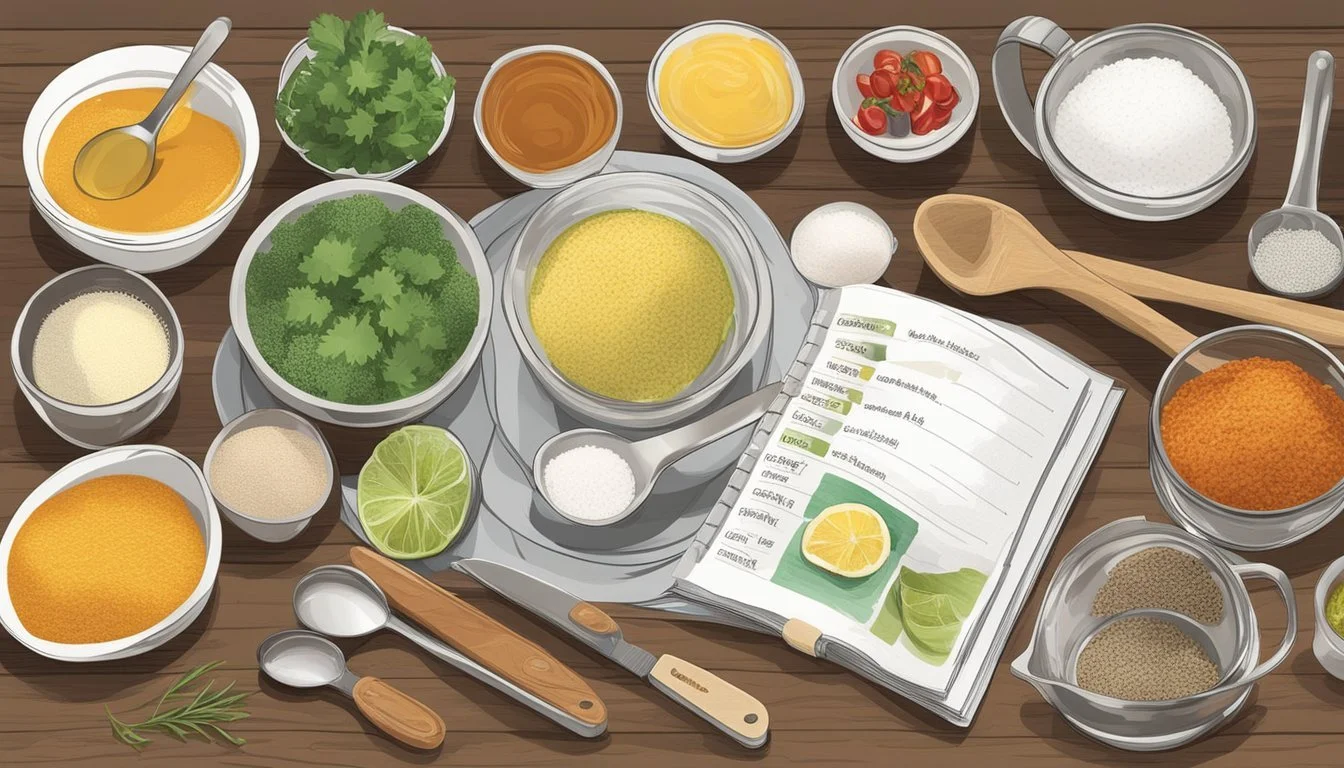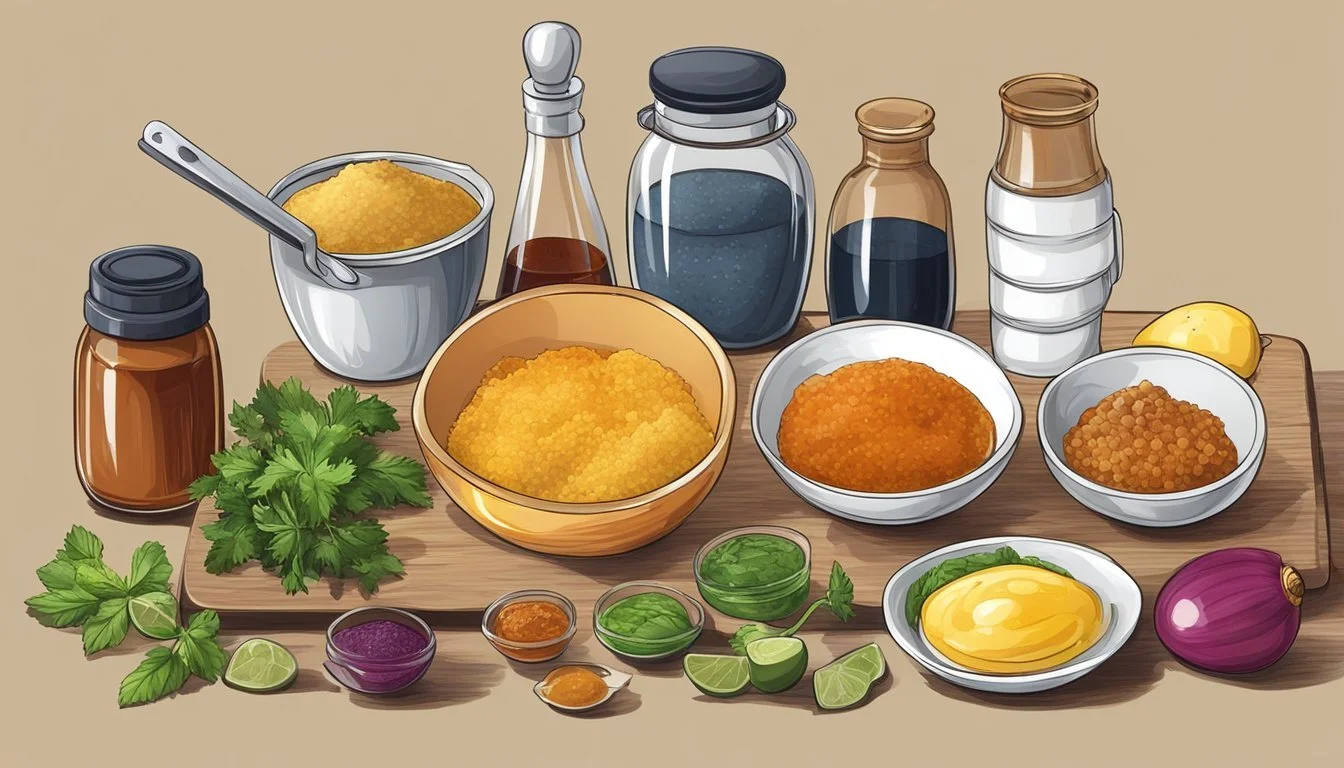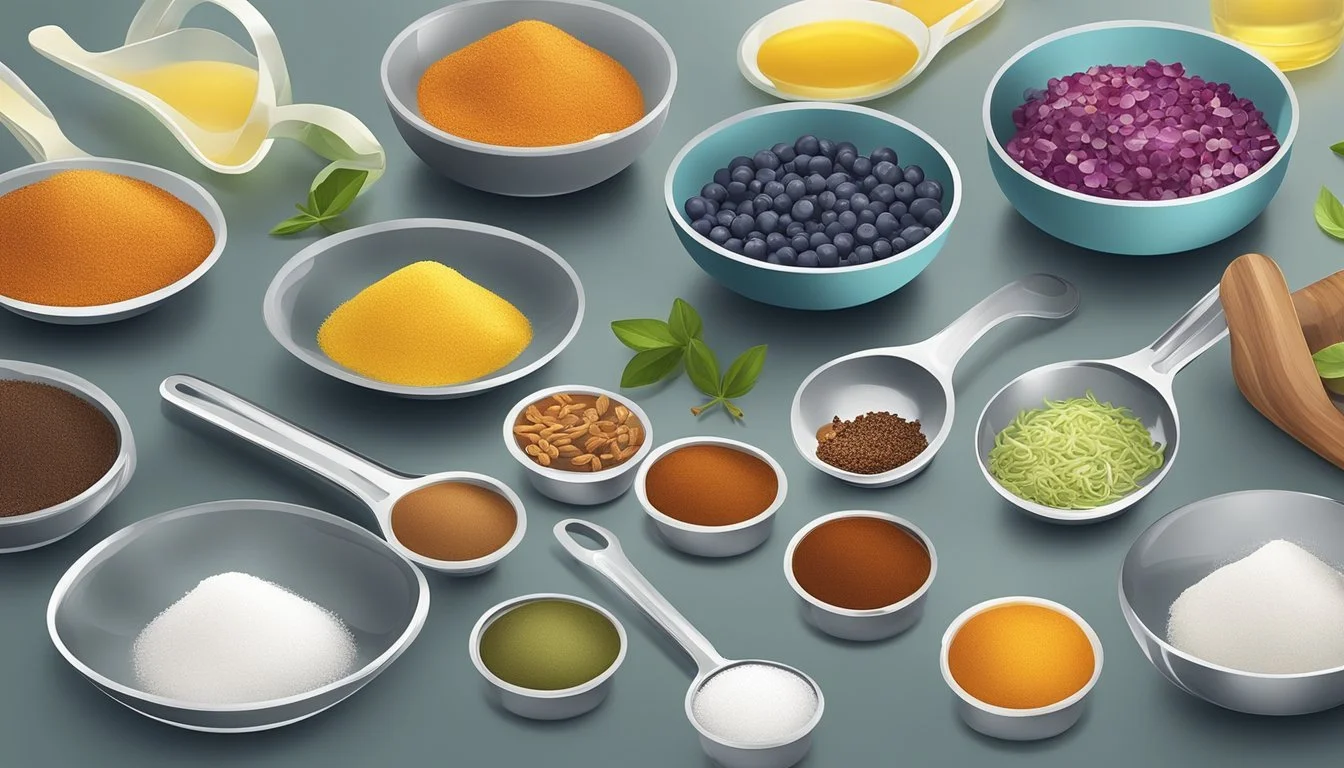How to Measure Ingredients for a Marinade
Precision for Perfect Flavor
Mastering the art of creating a marinade is pivotal for adding flavor and tenderness to meats. A marinade typically comprises three key components: an acid to tenderize, oil to moisturize and carry flavors into the meat, and seasonings to enhance taste. Measuring these ingredients accurately is essential for achieving the perfect balance between flavor and texture without overpowering the natural taste of the meat.
To ensure this balance, a general guideline is to maintain a ratio of three parts oil to one part acid. Fats like olive oil, canola oil, or coconut milk serve to ground flavor profiles and help the meat retain moisture during cooking. Meanwhile, acidic components such as vinegar, citrus juice, or wine tenderize the meat and assist in flavor absorption.
Exercising precision when measuring seasonings is also crucial, as the right amount can elevate the marinade without overshadowing the main ingredients. Whether it's salt, herbs, or sweeteners like honey or brown sugar, their thoughtful incorporation will result in a marinade that complements and enhances the overall dish.
Understanding Marinades
Marinades are integral to enhancing the flavor of food before cooking. They consist of acids, oils, and a variety of seasonings that work together to tenderize and infuse the food with depth and aroma.
Composition of a Marinade
A marinade typically contains three basic components: an acid, an oil, and seasonings. The acid could be vinegar, lemon juice, or wine, which helps tenderize the protein and carry flavor into the food. Oil helps to transfer fat-soluble flavors from ingredients like spices and herbs, and seasonings which include salt, sugar, and pepper, add distinct flavors and can also assist in the tenderizing process.
Role of Acids
Acids, such as vinegar or lemon juice, play a crucial role in marinades by breaking down proteins and tenderizing the meat. This process allows the meat to absorb more juices, resulting in a more tender and moist dish after cooking. Acids should be used judiciously since too much can overpower other flavors or overly soften the food.
Function of Oils
The presence of oil in a marinade serves multiple functions. It acts as a binding agent, helping the mixture adhere to the food's surface and can also help to lock in moisture during the cooking process. Oils like olive oil are preferred due to their own flavor profiles that can complement the overall taste of the marinade.
Importance of Seasonings
Seasonings refer to a range of ingredients including salt, sugar, spices, and herbs. These are pivotal in creating the intended flavor of the marinade. Salt is essential for its ability to enhance other flavors and assist in moisture retention. Herbs and spices, meanwhile, contribute their unique flavors, while sugar can add a touch of sweetness and aid in caramelization when cooking.
Selecting Ingredients
Creating a marinade begins with selecting the right ingredients that will enhance the flavor and texture of your chosen protein. The chosen ingredients will affect the overall health profile of the meal, including factors like fat, calories, and vitamins.
Choosing Proteins
When it comes to proteins, the type and cut matter. For instance, chicken breasts (What wine goes well with chicken breast?) are lean, offering high protein with low fat and calories. They're an excellent canvas for a marinade, as their mild flavor absorbs spices and herbs well. On the other hand, red meats like beef offer more iron but typically contain more fat and calories.
Opting for Freshness
The freshness of ingredients can significantly impact not only the taste but also the nutrient content of your marinade. Fresh herbs and spices often provide more potent flavors and higher levels of vitamins such as Vitamin A and Vitamin C, while fresh citrus or vinegar provide the acidic environment necessary for tenderizing the protein. Always prioritize fresh, high-quality ingredients for the best results, as they lend more vibrant flavors and contribute valuable nutrients like potassium and calcium.
Health Considerations
Considering the health impact of each component in your marinade is key. For health-conscious diners, it's important to balance taste with nutritional content. A marinade with a base of olive oil offers healthy fats, while fresh garlic or herbs can add flavor without unwanted sodium. For those tracking their carbohydrate intake, using sweeteners like honey must be moderated to maintain a balanced diet.
Marinade Preparation
Creating the perfect marinade involves precise measurement and blending of ingredients to ensure balanced flavors and optimal tenderizing properties. Proper technique is crucial for a marinade that enhances the natural taste of the meat without overpowering it.
Measuring Techniques
When preparing a marinade, measurement accuracy is key. Standard kitchen tools like measuring spoons and cups are essential. For dry ingredients like garlic powder, sugar, salt, and pepper:
Teaspoons (tsp) or tablespoons (Tbsp) for smaller quantities.
Cups (c) for larger volumes.
For liquids like soy sauce, olive oil, honey, balsamic vinegar, and citrus juice:
Use a liquid measuring cup for volumes larger than 2 tablespoons.
Measuring spoons suffice for anything less.
Ingredient Measurement Soy sauce 1/4 cup Olive oil 1/2 cup Honey 2 Tbsp Orange juice 1/3 cup Mustard 1 Tbsp
Mixing Components
Combining ingredients effectively determines the marinade's potency. Begin by whisking together your acidic components such as citrus juice or vinegar with oil to create an emulsion. This mixture serves as the base for the marinade. Gradually incorporate seasonings like minced garlic, salt, and pepper, ensuring an even distribution throughout. If using sugar or honey for sweetness, confirm it's fully dissolved.
Customizing Flavors
A marinade is versatile, allowing for customization to suit any palate or recipe. To tailor flavors:
Start with a foundation of soy sauce for umami, sesame oil for nuttiness, or olive oil for richness.
Incorporate acids like balsamic vinegar or orange juice for a tenderizing effect and bright profile.
Balance flavors with sweeteners; a touch of honey can offset tanginess.
Amplify the marinade with bold mustards or ground pepper for complexity.
Adjust salt sparingly; many ingredients like soy sauce already contain sodium.
Remember, tasting as you go ensures a marinade that complements the dish, and even simple ingredients can create a delectable result.
Marinating Process
The marinating process involves the careful preparation of meat, consideration of the time it should marinate to achieve the desired flavor and tenderness, and using appropriate containers to ensure the marinade's effectiveness.
Meat Preparation
Before marinating, one must ensure the meat is ready to absorb the flavors. For chicken breasts, it's crucial to have them cleaned and patted dry. Slicing the breasts uniformly can enhance the marinate's ability to tenderize and flavor evenly. A meat's surface should be exposed maximally to the marinade without compromising its structure.
Marinating Time Frames
The duration that meat, such as chicken breasts, should marinate is pivotal. Typically, a minimum of 30 minutes and a maximum of 24 hours is recommended, as longer periods don’t necessarily improve flavor further and may affect texture adversely. The following table outlines recommended time frames for different kinds of meats:
Meat Type Recommended Marinating Time Chicken Breasts 30 minutes to 2 hours Beef 4 hours to 24 hours Lamb 4 to 8 hours Fish 15 minutes to 1 hour
Note: Marinating for beyond these times can lead to meat becoming too soft or mushy.
Using the Correct Containers
Choosing the right container is important when marinating. Glass or plastic bowls with sealed lids, or zip-top plastic bags, are best suited for this purpose. They should be large enough to allow the meat to be fully submerged and the marinade to cover all surfaces. The container must be placed in the refrigerator during the marinating process to keep the meat safe from bacterial growth and to maintain the quality of the marinade. Avoid using metal containers as they can react with acidic components in the marinade and alter the flavor.
Cooking Techniques
When preparing marinades for different cooking techniques, one must adjust measurements to accommodate the specific heat and cooking environment. The goal is to achieve a tender, moist, and flavor-enriched result, whether it's grilled chicken or a baked delight.
Grilling
Grilling requires a robust marinade, as the high direct heat can quickly dry out the meat. A typical marinade ratio for grilling might be three parts oil to one part acid. For a juicy and flavorful grilled chicken, ensure the marinade fully coats the meat. Key points for grilling include:
Marination Time: Chicken should marinate for at least 30 minutes and up to 24 hours.
Oil-to-Acid Ratio: A higher oil content ensures the meat retains moisture and tenderness.
Marinade Coverage: Use enough marinade to cover the chicken pieces thoroughly.
Baking
For Baking, a chef has more control over the cooking environment. Baked items do not require as much oil in their marinades because the cooking process is generally more gentle, and the consistent heat distributes flavors uniformly. When baking marinated chicken, consider:
Marination Time: Bake marinades can be lighter, focusing on seasoning rather than tenderization.
Herbs and Spices: Infuse the marinade with herbs and spices that complement baking, such as rosemary or thyme.
Pan-Frying
Pan-Frying is an interactive cooking method where the marinade not only flavors the meat but also creates a base for the resulting pan sauce. A marinade for pan-frying might be richer in seasoning to enhance the final dish. Important considerations include:
Marination Time: Shorter than grilling, typically no more than a couple of hours for chicken.
Pan Sauce Potential: Reserved marinade can be reduced and combined with pan drippings for a flavorful sauce.
Oil Content: Less oil is needed in the marinade, as additional fat is often added to the pan during cooking.
Serving Suggestions
When crafting the perfect marinade, one must not only consider the balance of flavors but also how it complements the dishes it accompanies. Offering a variety of sides and presenting them artfully ensures that the marinade’s flavors are both enhanced and appreciated.
Pairing with Sides
Salads: A simple green salad dressed with a vinaigrette that echoes the acidic component of the marinade ties the meal together.
Vegetables: Grilled or roasted vegetables benefit from a brush of the marinade before serving, adding an extra layer of flavor.
Starchy Sides: Consider serving a starchy side like garlic mashed potatoes or rice pilaf to absorb the marinade’s flavors and provide a satisfying balance to the meal.
Presentation Tips
Condiments: Offer condiments on the side that align with the marinade's profile, such as chutneys or relishes, to allow guests to tailor the taste to their preference.
Plating: Plate the marinated main dish attractively with attention to color and contrast, garnishing with fresh herbs for a pop of color and nutrition.
Serving: Serve marinade-brushed entrées on warm plates to enhance the aromas and flavors of the marinade.
Portion Control: Be mindful of nutrition by controlling portion sizes, particularly with rich, marinated meats.
Marinade Variations
Crafting the perfect marinade involves zeroing in on the ideal balance of components for different types of proteins and diets. The following subsections provide specific alternatives suited for meat and poultry, vegetarian and vegan options, and draw inspiration from a variety of world cuisines.
Meat and Poultry Alternatives
For meats such as beef and pork, robust herbs like rosemary and thyme, coupled with rich sweetness from maple syrup or brown sugar, enhance the savory depth. Chicken benefits from citrus acids or Worcestershire sauce for tenderizing, with spices like paprika, black pepper, and minced garlic to boost flavor.
Seafood and fish like shrimp and salmon call for gentler acids such as lemon juice, which won't overpower their delicate taste. Adding oregano and parsley can impart a fresh, herby note.
Vegetarian and Vegan Options
Tofu is a blank canvas that readily absorbs a blend of soy sauce, ginger, and garlic powder. Incorporating ingredients such as brown sugar or maple syrup provides a sweet contrast to the savory elements.
Herbs & Spices Sweeteners Acidic Components - Ginger - Maple syrup - Lemon juice - Minced garlic - Brown sugar - Vinegar - Black pepper
Diverse Cuisine Inspirations
Asian-inspired marinades might include soy sauce, ginger, and sesame oil for an aromatic, umami-rich infusion suitable for chicken or beef.
A Latin American twist can come from lime juice, cilantro, and paprika, perfect for marinading pork or shrimp.
Mediterranean palates would appreciate the use of olive oil, garlic, oregano, and lemon zest, which complements seafood and poultry alike.
By experimenting with these ingredients, one can prepare marinades that are not only appealing to the tastebuds but also cater to a wide array of dietary preferences and cultural tastes.
Safety and Storage
Marinade safety and storage are critical to prevent foodborne illnesses, preserving the quality and flavor of the marinade, and ensuring meat is properly prepped for cooking.
Marinade Handling
When one prepares a marinade, it is essential to always start with a clean workspace and utensils. The container or bowl used to marinate should also be clean and suitable for use with acidic ingredients that some marinades contain. Once ingredients are combined, they should transfer the marinade and meat into the refrigerator without delay.
Refrigeration and Freezing
Marinating should occur in the refrigerator, never on the counter, to keep the food at a safe temperature — below 40°F. Refrigeration prevents bacteria growth during marination. If the plan is to marinate for longer durations, or if preparing a marinade for future use, freezing is a safe option. Place the marinade in a freezer-safe container or bag, label it clearly with the contents and date, and use within three months for best quality.
Avoiding Cross-Contamination
To ensure safety, never reuse marinade that has come into contact with raw meat without cooking it first. If one desires to use the marinade as a baste, set aside a portion beforehand or heat the used marinade to a rolling boil to kill any harmful bacteria. After marinating meat, poultry, or seafood, prevent cross-contamination by using separate utensils and plates from those used in pre-cooked or ready-to-eat foods. Clean all surfaces and utensils with hot, soapy water or a kitchen disinfectant after they come in contact with raw marinated meat, especially before anything is placed on the grill or taken to cook.
Enhancing Nutritional Value
Creating a marinade not only imparts flavor but also presents an opportunity to boost the nutritional content of meals. Careful selection and measurement of marinade components can increase essential nutrients while ensuring the dish remains healthy.
Reducing Sodium and Sugars
Sodium: To lower sodium content, one may use low-sodium soy sauce or replace traditional soy sauce with a dash of balsamic vinegar. Lemon juice also adds a tangy zest without the added sodium.
Sugars: Instead of using high-calorie sweeteners like sugar or honey, one could opt for a modest amount of maple syrup, which contains trace elements of minerals such as calcium and iron.
Incorporating Healthy Fats
Utilizing fats that contribute to nutrition is key. Incorporate:
Olive oil: A source of monounsaturated fats, rich in vitamin E.
Italics are for emphasis.*
Vinegar and lemon juice: While not fats, using these in balance with olive oil can enhance flavors without compromising the healthy fat benefits provided by the olive oil.
Selecting Nutrient-Dense Components
Fiber: Additions such as finely chopped garlic or herbs not only enhance flavor but can also contribute small amounts of dietary fiber.
Vitamins A and C: Incorporate ingredients like citrus zest or finely chopped bell peppers to provide a boost of these vitamins.
Calcium and Iron: A splash of a fortified vinegar variant can contribute to the calcium and iron content.









